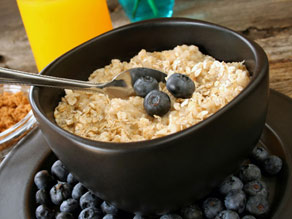Cholestrol Lowering Tips From Health

How to lower your cholesterol with better eating
Story Highlights
*Saturated fat is likely to raise blood cholesterol more than any other food in your diet
*Too much abdominal fat is particularly heart-unhealthy
*Soluble fiber helps trap cholesterol in the digestive tract
*You should eat foods containing plant stanols and sterols with meals twice a day
By Kate Stinchfield
About one in two American adults has borderline or high cholesterol levels, which increase one's risk of heart attack and cardiovascular disease.
Statins, medications that lower levels of low-density lipoprotein (LDL) cholesterol, are now among the most prescribed drugs in the country (and the world). But medication is only part of the solution: To keep cholesterol under control, maintaining a healthy weight and diet is just as important as taking a daily pill.
The guidelines for treating high cholesterol from the National Cholesterol Education Program recommend that patients try to lower their cholesterol through Therapeutic Lifestyle Changes (TLC), which include exercise and a healthy diet, before starting a statin.
Lowering your cholesterol through eating habits and exercise means you can avoid the risk of side effects from medication entirely. Indeed, the only side effects of TLC you'll encounter are more energy, weight loss, and better overall health.
To help decrease your cholesterol without a statin -- or to supplement the statin you're already taking -- follow these guidelines from the TLC diet.
Reduce saturated fat to no more than 7 percent of total calories, and cholesterol to no more than 200 milligrams per day
Saturated fat is likely to raise blood cholesterol more than any other food in your diet (except for, perhaps, trans fats, which are slowly being phased out of many foods). A goal of just 7 percent of total calories is no more than 16 grams per day for most people. To stay within these boundaries, eat more of a plant-based diet with fruits, vegetables, and whole grains, and limit red meat, full-fat dairy products, baked goods, and fried foods. Read about more foods to avoid
Read labels and try to track your daily saturated fat grams until you get an idea of how much your typical food choices contain; don't rely solely on the Percent Daily Values listed, since they're based on the diet of someone who doesn't have high cholesterol and thus can eat slightly more saturated fat. An added bonus: Lowering your saturated fat intake means you'll help lower cholesterol intake as well, since saturated fat and cholesterol tend to be found together.
If you're overweight, reduce calories and work toward your ideal body weight
It's unclear exactly why being overweight tends to increase blood cholesterol, but too much abdominal fat is particularly heart-unhealthy. Video: See why your spare tire is so dangerous
Women should strive to keep their waist circumference below 35 inches and men below 40. If you are overweight, losing just 10 percent of your body weight can provide a significant health improvement. Use this interactive tool to see your weight-related health profile.
Add 5 to 10 grams of soluble fiber a day
Soluble fiber is found in oats, beans, fruits, and vegetables -- it's why products like Cheerios can claim heart-healthy benefits. Soluble fiber helps trap cholesterol in the digestive tract so that it passes through your body rather than getting into your bloodstream. Eating oatmeal breakfasts and having whole fruits as snacks can get you closer to this goal.
Add 2 grams of plant stanols and sterols to your daily diet
Plant stanols and sterols are natural compounds found in vegetable oils, nuts, and seeds that compete with cholesterol for absorption into the bloodstream from the gastrointestinal tract and thus decrease the amount of cholesterol that makes it into your system. Stanol- and sterol-enhanced foods and beverages have become commonplace in supermarkets, from margarines and spreads to orange juice. For best results, eat foods containing plant stanols and sterols with meals twice a day.
Practice therapeutic lifestyle changes
These adjustments, combined with exercise and consultations with a doctor, make up the TLC program. By following this plan, you may be able to avoid the cost, hassle, and potential side effects of prescription drugs -- or at least keep your dose down.
Try a FREE TRIAL issue of Health - CLICK HERE!


1 Comments:
At 12:32 PM, Sandi said…
Sandi said…
I love reading your blog ... it really is an inspiration, and I love how you find all the healthy eating and exercise articles. Thank you!!
Post a Comment
<< Home